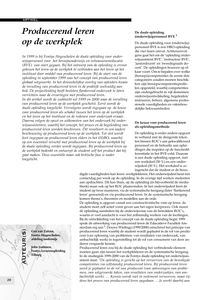Purpose – purpose of this article is to report about the progress of the development of a method that makes sense of knowledge productivity, in order to be able to give direction to knowledge management initiatives. Methodology/approach – the development and testing of the method is based on the paradigm of the Design Sciences. In order to increase the objectivity of the research findings, and in order to test the transferability of the method, this article suggests a methodology for beta testing. Findings – based on the experiences within this research, the concept of beta testing seems to fit Design Science Research very well. Moreover, applying this concept within this research resulted in valuable findings for further development of the method. Research implications – this is the first article that explicitly applies the concept of beta testing to the process of developing solution concepts. Originality/value – this article contributes to the further operationalization of the relatively new concept of knowledge productivity. From a methodological point of view, this article aims to contribute to the paradigm of the Design Sciences in general, and the concept of beta testing in particular.
DOCUMENT

In the knowledge economy knowledge productivity is the main source of competitive advantage and thus the biggest management challenge. Based on a review of the concept from two distinct perspectives, knowledge productivity is defined as the process of knowledge-creation that leads to incremental and radical innovation. The two main elements in this definition are „the process of knowledge creation‟ and „incremental and radical innovation‟. The main aim of this chapter is to contribute to a better understanding of the concept of knowledge productivity in order to support management in designing policies for knowledge productivity enhancement. After elaborating on the concept of knowledge productivity, the two main elements are combined in a conceptual framework – the knowledge productivity flywheel. This framework appeared to be an effective model for supporting initiatives that aim for enhancing knowledge productivity.
DOCUMENT

LINK
Hoofdstuk 19 uit boek. (Deel II Vormgeving van de leeromgeving).
DOCUMENT

The sources of productivity have always been the main subject of economic debate because they are the main determinants of profitability and competitiveness. In order to improve productivity we should be able to identify the sources of productivity. This article presents a method for measuring the sources of knowledge productivity in order to give direction to knowledge management initiatives. The method is based on a theoretical framework which combines two different perspectives (economic and process) on knowledge productivity. This article presents the methodological and theoretical framework, the initial design of the method and the results of the first two case studies. The relevance of this article is that it combines the concepts of knowledge management and intellectual capital measurement in the relatively new concept of knowledge productivity.
DOCUMENT

In België ontstond enkele jaren geleden een opleiding die de kloof moest dichten tussen de leefwereld van mensen in armoede en de ‘systeemwereld’ van de organisaties met wie zij te maken hebben. Nu is deze opleiding overgewaaid naar ons land. Ervaringsdeskundige Heidi van der Laan is er enthousiast over
MULTIFILE

In deze publicatie wordt een 'tool' aangeboden om te komen tot het optimaliseren van de technische bedrijfsvoering. Deze tool is ontwikkeld in het kader van het project "Procesinnovatie Verspaning voor MKB-bedrijven".
DOCUMENT

In 1999 is bij Fontys de duale opleiding voor het Beroepsonderwijs en volwasseneneducatie (Bve) van start gegaan. In het artikel Duaal opleiden samen met ROC s: drie jaar maatwerk-ervaring (P.L.van der Plas, 2002) wordt deze opleiding nader toegelicht. In het onderwijsmodel vormt de opleiding tot onderwijsassistent de eerste fase. Bij het ontwerp van de opleiding is gekozen voor een nieuwe opleidingsmethode, producerend leren, die het leren op de werkplek verbindt aan het leren op de opleiding. Bij de start van de opleiding in september 1999 was het concept van producerend leren globaal uitgewerkt. In het drie-wekelijkse overleg van opleiders kwam de invulling van producerend leren in de praktijk veelvuldig aan bod. De projectleiding heeft besloten flankerend onderzoek te laten verrichten naar de vraag Wat is producerend leren voor dit duale opleidingstraject, hoe wordt het ingevuld en hoe zou het moeten worden ingevuld volgens de participanten? Participanten bij producerend leren zijn de duale studenten, ROC-coaches en Fontys-opleiders. In dit artikel wordt eerst ingegaan op de keuze voor producerend leren als opleidingsmethode. Vervolgens worden de onderzoeksaanpak toegelicht en de voornaamste onderzoeksresultaten gepresenteerd. Afsluitend wordt gekeken naar de invulling van producerend leren elders in het onderwijs alsmede naar de vraag of producerend leren een rol kan spelen voor het inrichten van de werkplek als krachtige leeromgeving.
DOCUMENT

LINK
The pervasiveness of wearable technology has opened the market for products that analyse running biomechanics and provide feedback to the user. To improve running technique feedback should target specific running biomechanical key points and promote an external focus. Aim for this study was to define and empirically test tailored feedback requirements for optimal motor learning in four consumer available running wearables. First, based on desk research and observations of coaches, a screening protocol was developed. Second, four wearables were tested according to the protocol. Third, results were reviewed, and four experts identified future requirements. Testing and reviewing the selected wearables with the protocol revealed that only two less relevant running biomechanical key points were measured. Provided feedback promotes an external focus of the user. Tailoring was absent in all wearables. These findings indicate that consumer available running wearables have a potential for optimal motor learning but need improvements as well.
DOCUMENT
